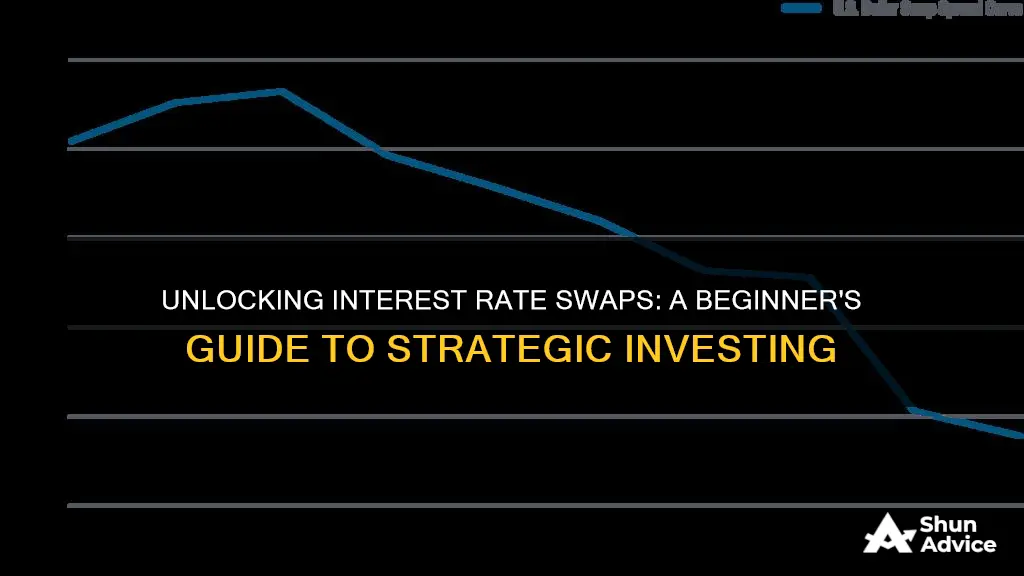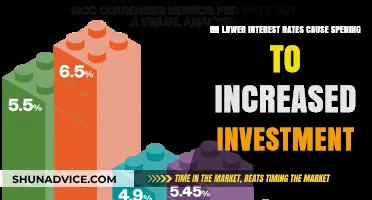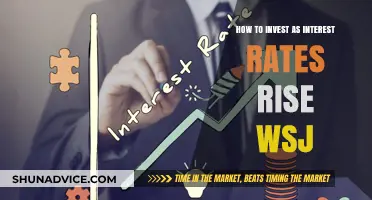
Interest rate swaps are a complex financial instrument that can be a valuable tool for managing risk and optimizing investment portfolios. This paragraph introduces the topic by explaining that interest rate swaps involve the exchange of cash flows between two parties based on the difference between two interest rates. It highlights the importance of understanding the mechanics of these swaps, including the roles of the swap dealer and the counterparty, as well as the potential risks and benefits associated with this investment strategy. The paragraph also emphasizes the need for investors to carefully consider their financial goals, risk tolerance, and market conditions before engaging in interest rate swaps.
What You'll Learn
- Understanding the Basics: Learn the fundamentals of swaps, including their purpose and how they work
- Market Participants: Identify key players in the swap market and their roles
- Valuation Methods: Explore techniques to determine the fair value of a swap contract
- Risk Management: Understand the risks associated with swaps and strategies to mitigate them
- Regulatory Considerations: Study the legal and regulatory framework governing interest rate swaps

Understanding the Basics: Learn the fundamentals of swaps, including their purpose and how they work
Swaps are financial derivatives that allow parties to exchange one stream of cash flows for another. They are an essential tool in the financial markets, providing a means to manage risk and gain exposure to different financial instruments. Understanding the fundamentals of swaps is crucial for anyone looking to invest in interest rate swaps, as it forms the basis of how these complex financial instruments operate.
The primary purpose of a swap is to transfer the risk associated with a particular financial instrument or market condition. For example, a company might want to protect itself against rising interest rates by swapping its floating-rate debt for a fixed-rate obligation. This is where the concept of 'swapping' comes into play; the company essentially trades one set of cash flows for another, mitigating the risk of adverse market movements.
In the context of interest rate swaps, two parties agree to exchange cash flows based on a specified interest rate. One party, the 'payer', agrees to pay a fixed interest rate to the 'receiver' over a defined period. Conversely, the receiver agrees to pay a floating interest rate, typically linked to a reference rate like LIBOR (London Interbank Offered Rate) or EURIBOR (Euro Interbank Offered Rate). This exchange of interest rates allows both parties to manage their exposure to interest rate risk.
The mechanics of an interest rate swap are relatively straightforward. At the start of the swap, both parties agree on the notional amount, which is the value of the loan or debt being swapped. This notional amount is used to calculate the cash flows that will be exchanged. The swap then operates over a specified period, with interest rate payments being made periodically according to the agreed terms.
Understanding the basics of swaps, including their purpose and mechanics, is essential for investors. It enables them to assess the potential risks and benefits of interest rate swaps. For instance, investors can evaluate the impact of changing interest rates on the swap's value and determine whether the swap provides the desired risk management or speculative opportunity. Additionally, knowledge of swap fundamentals can help investors navigate the legal and regulatory considerations associated with these complex financial instruments.
Navigating the Megarive: Strategies for Investing in a Rising Interest Rate Environment
You may want to see also

Market Participants: Identify key players in the swap market and their roles
The interest rate swap market is a complex and dynamic financial environment, and understanding the various participants is crucial for anyone looking to invest in these instruments. Here's an overview of the key players and their roles:
- Swap Dealers/ Brokers: These are the primary market makers in the interest rate swap market. Swap dealers are financial institutions that specialize in trading and facilitating swap agreements. They act as intermediaries between buyers and sellers, providing liquidity and ensuring that trades can be executed efficiently. Brokers, on the other hand, are often self-employed individuals or small firms that assist in the trading process by sourcing deals, negotiating terms, and executing trades on behalf of their clients. These professionals have extensive knowledge of the market and can provide valuable insights to investors.
- End-Users: End-users are entities that enter into swap agreements to manage their exposure to interest rates. This category includes a wide range of participants, such as commercial banks, financial institutions, corporations, and even governments. For example, a company might use interest rate swaps to hedge against potential increases in borrowing costs, ensuring more stable cash flows. End-users can be further classified into two main groups: hedgers and speculators. Hedgers use swaps to manage risk, while speculators aim to profit from price movements in the swap market.
- Clearing Houses: In the interest rate swap market, clearing houses play a vital role in ensuring the smooth operation of trades. They act as intermediaries between swap dealers and end-users, providing a platform for trade execution and risk management. Clearing houses guarantee the performance of the swap agreements, reducing counterparty risk. This is particularly important in the swap market, where the contracts can be highly customized and complex. By centralizing the clearing process, these houses enhance market stability and provide a safety net for investors.
- Regulators and Supervisors: Regulatory bodies and financial supervisors are essential to maintaining the integrity and stability of the swap market. They set and enforce rules, monitor market activities, and ensure that participants adhere to legal and ethical standards. Regulators like the SEC (Securities and Exchange Commission) in the United States and similar bodies worldwide oversee the trading activities, reporting requirements, and disclosure standards for interest rate swaps. Their role is critical in preventing market manipulation, ensuring fair practices, and protecting investors.
Understanding the roles of these market participants is essential for investors to navigate the interest rate swap market effectively. Each player contributes to the overall functioning and liquidity of the market, and their interactions create a complex web of financial transactions.
Unveiling the Interest Rates: Are Investment Loans Worth the Cost?
You may want to see also

Valuation Methods: Explore techniques to determine the fair value of a swap contract
When it comes to valuing interest rate swap contracts, several methods can be employed to determine their fair value. Here's an overview of some key techniques:
- Discounted Cash Flow (DCF) Analysis: This method is widely used for valuing financial instruments, including swaps. DCF analysis involves projecting future cash flows from the swap contract and discounting them back to the present value using an appropriate discount rate. The discount rate is crucial here; it should reflect the risk-free rate plus an appropriate credit spread based on the counterparty's creditworthiness. By summing the present values of these cash flows, you can estimate the fair value of the swap.
- Market Approach: Another common valuation technique is to compare the swap contract with similar instruments in the market. This involves analyzing recent transactions and market prices of comparable swaps. By studying the market data, you can identify the prevailing prices and adjust them based on factors like maturity, currency, and credit quality. This approach provides a relative valuation and can be useful when market data is readily available.
- Risk-Neutral Pricing: This method is particularly applicable to interest rate swaps and involves modeling the swap's future cash flows under different interest rate scenarios. You would use a risk-neutral pricing framework, where the swap's value is calculated as the expected present value of its future cash flows, discounted at the risk-neutral rate. This technique is more complex and often requires the use of numerical methods or specialized software.
- Monte Carlo Simulation: For more complex swaps, especially those with multiple legs or exotic features, Monte Carlo simulation can be a valuable tool. This technique uses random sampling to model potential future scenarios and their associated cash flows. By running multiple simulations, you can estimate the range of possible values for the swap contract, providing a more comprehensive valuation.
Each of these methods has its advantages and is chosen based on the specific characteristics of the swap contract and the available data. It's important to consider factors like liquidity, market volatility, and the counterparty's credit risk when applying these valuation techniques. Additionally, regulatory guidelines and industry standards often provide frameworks for valuing swaps, ensuring transparency and consistency in the financial markets.
Unlock Argentina's Investment Potential: Navigating Interest Rates for Success
You may want to see also

Risk Management: Understand the risks associated with swaps and strategies to mitigate them
When considering interest rate swaps as an investment strategy, it's crucial to understand the inherent risks and employ effective risk management techniques. These risks primarily revolve around the potential for significant financial losses due to adverse market movements. Here's an in-depth look at the risks and the strategies to mitigate them:
Market Risk: This is the primary concern in interest rate swaps, as the value of the swap is directly tied to market conditions. If market interest rates move against the position, the swap's value can decrease, leading to potential losses. For instance, if a swapper anticipates rising interest rates and enters into a long swap position, a sudden drop in rates could result in a negative swap value. To manage this risk, investors should closely monitor market trends and consider using derivative instruments like options or futures to hedge their positions. These hedging tools allow investors to lock in favorable rates or protect against adverse movements, thus reducing the impact of market volatility.
Credit Risk: In the context of swaps, credit risk refers to the possibility of one party defaulting on their obligations, which could lead to financial losses for the other party. This risk is particularly relevant in over-the-counter (OTC) swaps, where counterparties may have varying creditworthiness. To mitigate credit risk, investors should conduct thorough credit analysis of the counterparties, assess their credit ratings, and consider using credit default swaps (CDS) to transfer or manage this risk. Regularly reviewing and updating credit assessments is essential to ensure the ongoing viability of the swap agreement.
Liquidity Risk: Swaps, especially those with unique terms, may not always be easily tradable in the market. This lack of liquidity can make it challenging to exit a position quickly, potentially resulting in losses if the market value of the swap changes unexpectedly. To address this, investors should carefully select swaps with terms that align with their investment horizon and consider the potential impact of liquidity on their overall strategy. Diversifying the swap portfolio across different maturities and counterparties can also help manage liquidity risk.
Operational Risk: This encompasses the risks associated with the execution and management of the swap agreement. Errors in calculation, processing, or documentation can lead to significant financial losses. To mitigate operational risk, robust internal controls and risk management processes should be in place. This includes regular reviews of swap agreements, accurate record-keeping, and the use of advanced technology to automate and streamline processes, thereby reducing the likelihood of human error.
Effective risk management in interest rate swaps involves a comprehensive understanding of the market, credit, liquidity, and operational risks. By employing strategies such as hedging, credit analysis, and robust operational controls, investors can navigate these risks and make informed decisions. Regular monitoring and adjustment of risk management strategies are essential to adapt to changing market conditions and ensure the preservation of capital.
Unleash Daily Compounding Power: Your Guide to Smart Investing
You may want to see also

Regulatory Considerations: Study the legal and regulatory framework governing interest rate swaps
When considering investing in interest rate swaps, it is crucial to understand the regulatory landscape that governs these financial instruments. Interest rate swaps are complex derivatives that involve the exchange of one party's interest payments for another's, typically based on a notional principal amount. The legal and regulatory framework surrounding swaps is designed to protect market participants, ensure transparency, and mitigate risks.
One key regulatory consideration is the oversight provided by financial authorities. In many jurisdictions, interest rate swaps are regulated by central banks or financial regulatory bodies. For example, in the United States, the Commodity Futures Trading Commission (CFTC) and the Securities and Exchange Commission (SEC) have overlapping authority over swaps, with the CFTC primarily regulating swaps traded on organized exchanges and the SEC focusing on swaps that are not cleared or traded on an exchange. Understanding the specific regulatory body responsible for overseeing swaps in your region is essential.
Study the relevant laws and regulations that apply to interest rate swaps. These may include derivatives regulations, such as the Dodd-Frank Act in the US, which imposes reporting and clearing requirements for swaps. Regulations often mandate that swap transactions be reported to regulatory authorities, ensuring transparency and enabling the monitoring of market activities. Additionally, look into any specific rules related to counterparty risk, which is a significant concern in swaps. Regulations might require the use of clearinghouses or standardized documentation to mitigate counterparty risk.
Furthermore, familiarize yourself with the legal documentation associated with interest rate swaps. Swap agreements are legally binding contracts that outline the terms and conditions of the swap, including the notional amount, interest rates, payment schedules, and termination provisions. Understanding the legal implications and potential risks associated with these contracts is vital. Seek legal advice if needed to ensure compliance with all applicable laws and to understand the rights and obligations of each party involved.
Stay informed about any changes in regulations and legal requirements. The regulatory environment for derivatives, including interest rate swaps, can evolve over time. Keep abreast of updates from regulatory bodies, as they may introduce new rules or modify existing ones to address market developments or emerging risks. This proactive approach ensures that your investment activities remain compliant and well-informed.
Unlocking Investment Interest: Strategies for Success
You may want to see also
Frequently asked questions
An interest rate swap is a financial derivative contract between two parties, where they agree to exchange cash flows based on two different fixed or floating interest rates. It is a way to manage interest rate risk or to speculate on the future direction of interest rates.
To invest in or participate in an interest rate swap, you typically need to have a counterparty, which could be another financial institution, a corporation, or an individual with sufficient financial resources and expertise. You would enter into a swap agreement with the counterparty, specifying the notional amount, the interest rates, and the frequency of payments. It's important to understand the risks involved, as swaps can be complex and are generally suited for sophisticated investors.
Interest rate swaps offer several advantages. Firstly, they allow investors to hedge against interest rate risk, protecting their portfolios from potential losses due to rising or falling interest rates. Secondly, swaps can provide a way to speculate on interest rate movements, potentially generating profits if the market moves in the expected direction. Additionally, swaps can be used to achieve certain financial goals, such as managing debt or optimizing cash flow.
While interest rate swaps can be a valuable tool, they also carry certain risks. One of the primary risks is credit risk, as the performance of the swap depends on the creditworthiness of the counterparty. If the counterparty defaults, the investor may face financial losses. Market risk is another consideration, as the value of the swap can be affected by changes in interest rates and market conditions. It's crucial to carefully assess the risks and ensure that the investment aligns with your risk tolerance and financial objectives.







